Building a bamboo trellis fence involves seven key steps: selecting high-quality bamboo and proper tools, planning your design based on purpose and space, preparing the site by clearing vegetation and marking boundaries, constructing a sturdy frame with proper spacing, assembling the trellis panels with tight lashings, securing posts 1-2 feet deep with gravel for drainage, and applying protective treatments like sealers or UV-protective stains. Following these steps will guarantee your sustainable garden feature stands the test of time.
Selecting the Right Bamboo Material and Tools
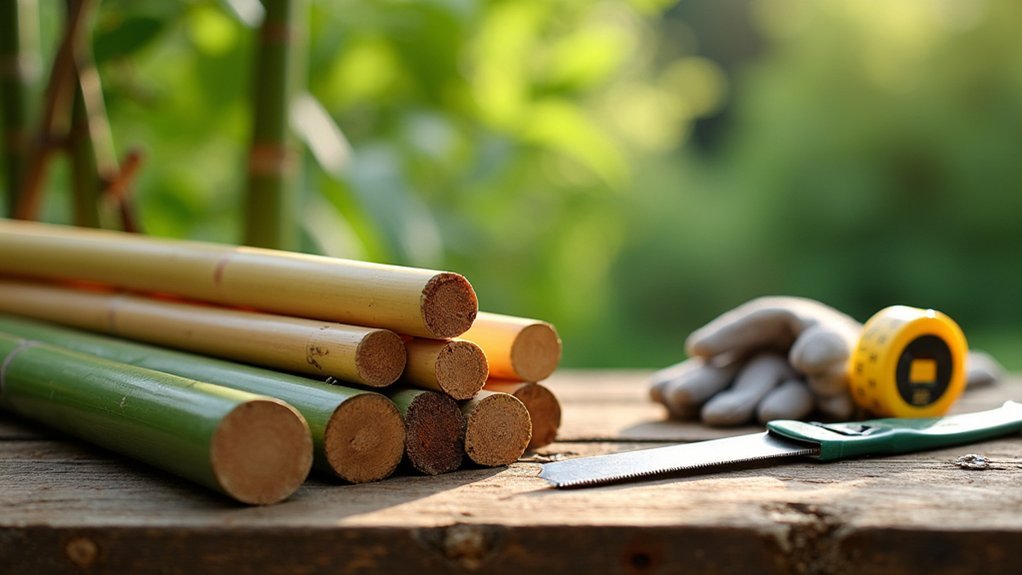
Three key factors determine the success of your bamboo trellis fence: material quality, proper tools, and correct preparation techniques.
Success with bamboo trellises hinges on three critical elements: premium materials, appropriate tooling, and meticulous preparation.
For ideal results, select high-quality bamboo varieties like those from China’s Anji region or consider thermally treated options like Bamboo X-treme for exceptional durability.
You’ll need several essential tools: a drill for creating pilot holes, a bamboo saw or fine hacksaw for precise cuts, protective gloves to prevent splinters, and a nail set to avoid splitting.
Traditional dark twine like *shuro nawa* works best for tying smaller pieces together. Using hemp twine or waxed lashing cord will ensure your joints remain tight and secure over time.
Remember that bamboo isn’t only structurally strong and flexible but also a sustainable, renewable resource that ages beautifully to a light gray.
Apply natural preservatives like hemp or tung oil to extend your trellis’s lifespan.
Planning Your Trellis Design and Layout
Before assembling a single bamboo pole, you’ll need a clear vision for your trellis project. First, determine your trellis’s primary purpose—whether for climbing plants, privacy, or purely aesthetic appeal.
Consider the location carefully, ensuring it provides proper sun exposure for your plants while complementing your garden’s layout. Your west-facing walls can be excellent locations for trellises as they offer ideal placement options for many climbing varieties.
Choose a design style that matches both your garden’s aesthetic and practical needs:
- Grid patterns work well for roses and jasmine
- Diagonal designs provide excellent support for heavier vines
- A-frame structures are perfect for vegetables like cucumbers
- Fan-shaped trellises create striking visual focal points
Measure your space thoroughly and sketch your design on paper, accounting for height, width, and the spacing between bamboo poles.
Don’t forget to factor in future plant growth when determining dimensions.
Preparing the Installation Site

Proper site preparation forms the foundation of a successful bamboo trellis fence.
Begin by clearing all vegetation, roots, and debris within your fence line. Contact utility services (811 in the U.S.) to identify underground lines before digging.
Level any uneven terrain and mark boundaries with string or stakes to visualize your layout. Test soil composition and amend with gravel or sand if it’s too loose.
For post holes, dig 18-24 inches deep, spacing them 6-8 feet apart. Line each hole with gravel at the base for better drainage. Consider using treated wood poles for improved resistance against moisture and ground contact.
Ensure you’ll maintain a 2-inch clearance between bamboo and ground to prevent rot. Slight sloping away from the fence will divert rainwater.
Don’t forget to check local permit requirements and property line setbacks before installation begins.
Constructing the Bamboo Frame
With your site properly prepared, the physical construction of your bamboo trellis fence begins. Select the appropriate bamboo type for your climate, guaranteeing it’s properly dried or treated to prevent rot. Cut your bamboo with precision—remember to cut vertical canes just above a node to prevent water collection. Bamboo trellises have an expected lifespan of 8-10 years before they begin to deteriorate.
Select bamboo suited to your climate and ensure it’s properly dried—proper preparation prevents premature deterioration of your trellis.
When assembling your frame, focus on these vital elements:
- Lay out your entire design on flat ground before permanent assembly
- Mark intersection points clearly for consistent lashing placement
- Use tight, secure knots with quality cord that can withstand weather
- Add reinforcing crossbeams for taller structures to guarantee stability
Test your frame’s stability before final installation. The strength of your trellis depends on proper lashing technique at intersections, so take your time with these connections for a durable, attractive result.
Assembling and Attaching Trellis Panels
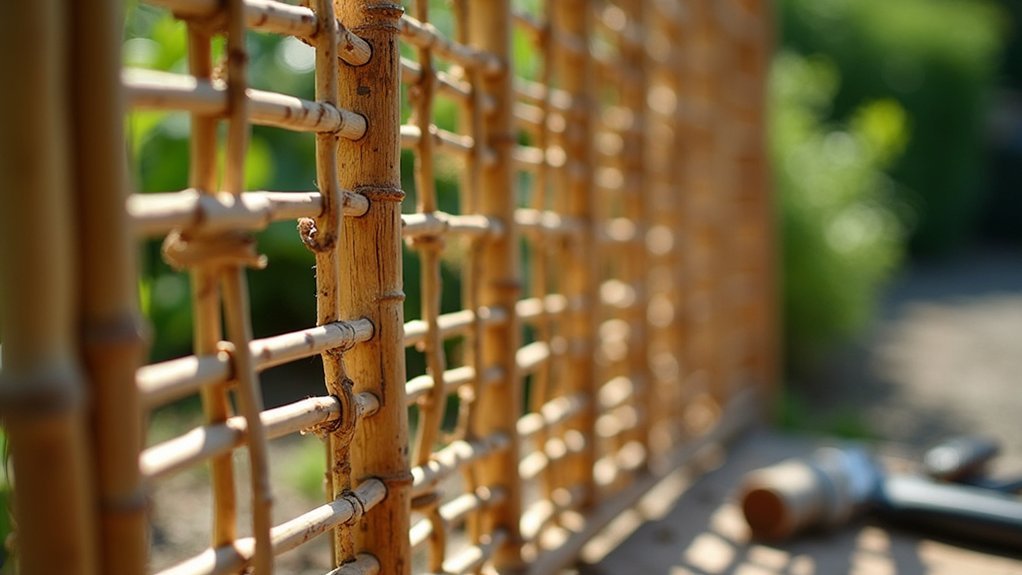
Once your bamboo frame is constructed, the next essential step involves assembling and attaching your trellis panels properly. Inspect panels for damage, straighten any dislodged slats, and apply a protective sealant to enhance durability. Position panels flush against your supporting structure, ensuring consistent orientation. For outdoor installations, use Total Wood Protector with UV protectant to prevent color fading and extend fence life.
| Attachment Method | Best Used For |
|---|---|
| Galvanized staples | Wooden fences |
| Zip ties | Chain-link fences |
| Deck screws | Pre-drilled holes |
| Wooden battens | Masonry walls |
| Steel wire | Multi-panel joining |
When fastening, space attachments every 12 inches for stability. For chain-link fences, secure zip ties around the metal framework—never directly on bamboo poles to prevent damage. Remember to pre-drill holes before inserting screws to avoid splitting the bamboo. Check that panels remain level throughout installation to prevent uneven sections.
Securing and Stabilizing Your Fence
Securing your bamboo trellis fence requires three critical considerations to guarantee it withstands environmental challenges and remains stable for years. Proper foundation work prevents future leaning or collapse, while reinforcement techniques add structural integrity.
Building a lasting bamboo trellis fence demands strategic foundation work and thoughtful reinforcement to withstand nature’s challenges.
Start by digging post holes 1-2 feet deep, exceeding your local frost line, and mix in gravel for drainage. Space support posts 6-8 feet apart and use rot-resistant materials for ground contact. Secure each intersection of bamboo pieces with waxed lashing cord for maximum durability and aesthetic appeal.
- Angle posts slightly outward (10-15°) to counter natural leaning tendencies
- Install horizontal crossbars between posts to prevent wind sway
- Elevate bamboo 2-3 inches above soil using gravel beds or wooden crossbeams
- Apply diagonal bracing at stress points and limit horizontal spans to 3-4 feet
For high-wind areas, consider concrete footings or tripod configurations for additional stability.
Applying Protective Treatments for Longevity
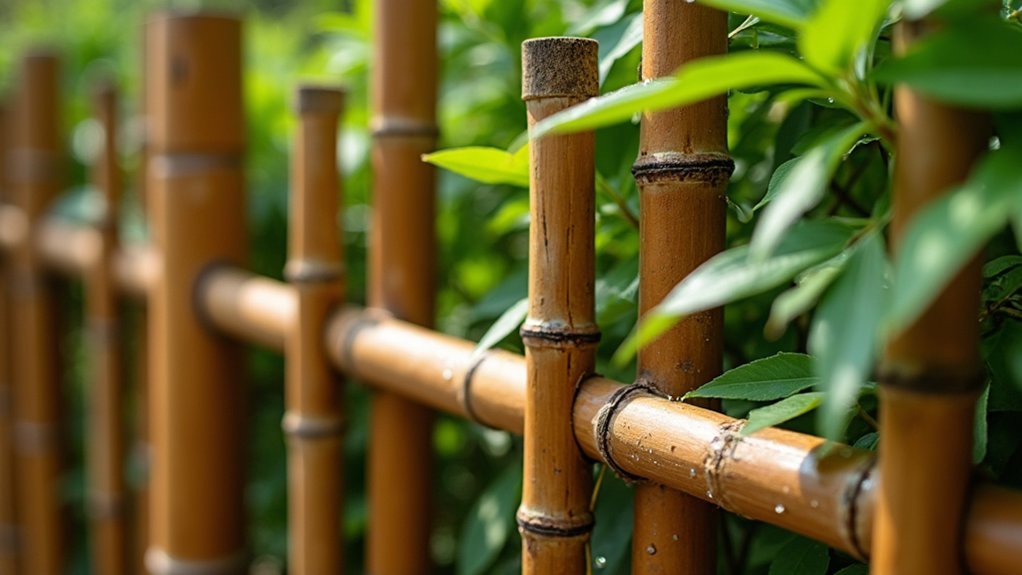
Applying proper protective treatments to your bamboo trellis fence directly impacts its lifespan, sometimes extending durability from 3-5 years to 10-15 years or more. Begin by lightly sanding the bamboo to remove its waxy cuticle, then clean thoroughly and let dry for 24-48 hours. Regular cleaning and proper sealing are essential maintenance steps that prevent deterioration and preserve the natural beauty of your bamboo structure.
| Treatment Type | Best For | Reapplication |
|---|---|---|
| Specialized bamboo sealers | General protection | Every 2-3 years |
| UV-protective stains | Sun-exposed areas | Every 2 years |
| Water-repellent formulas | High-rainfall regions | Annually |
| Fungicidal treatments | Humid environments | Every 1-2 years |
Apply treatments with a brush in 50-80°F temperatures, focusing on end-grains and horizontal poles. Two thin coats work better than one thick layer. In harsh climates, choose sealers with specific protective properties for your environment.
Frequently Asked Questions
How Long Will a Bamboo Trellis Fence Typically Last?
Your bamboo trellis fence will typically last 2-3 years without maintenance. With proper care like regular cleaning, staining, and sealing, you’ll extend its lifespan to 5-15 years depending on the bamboo type.
Can Bamboo Trellis Fences Withstand Heavy Snow or High Winds?
Bamboo trellis fences can withstand moderate snow and winds, but they’re vulnerable to heavy loads. You’ll need proper installation, reinforcement, and regular maintenance. Consider using thicker bamboo poles and secure anchoring for harsh conditions.
Is Permission Needed From Neighbors Before Installing Boundary Trellis Fences?
Yes, you’ll typically need permission if you’re attaching to a neighbor’s fence or building on a shared boundary. Check local zoning laws, HOA rules, and consider getting written consent to avoid future disputes.
How Do I Prevent Bamboo From Splitting During Installation?
To prevent bamboo from splitting during installation, you’ll need to guarantee it’s properly dried, handle it gently, use wood conditioners, maintain consistent moisture levels, and avoid overtightening cables or supports when securing it.
Can I Create Curved or Circular Bamboo Trellis Designs?
Yes, you can create curved bamboo trellis designs. Soak fresh bamboo in water first to increase flexibility, then gradually bend it into your desired shape and secure with strong lashing cord or wire.
In Summary
You’ve now mastered all the steps to create a beautiful bamboo trellis fence. With proper material selection, thoughtful design, and careful construction, you’ll enjoy this sustainable, natural barrier for years to come. Don’t forget regular maintenance and protective treatments to preserve your fence against weather elements. Your new bamboo trellis isn’t just functional—it’s an artistic expression that enhances your outdoor space.



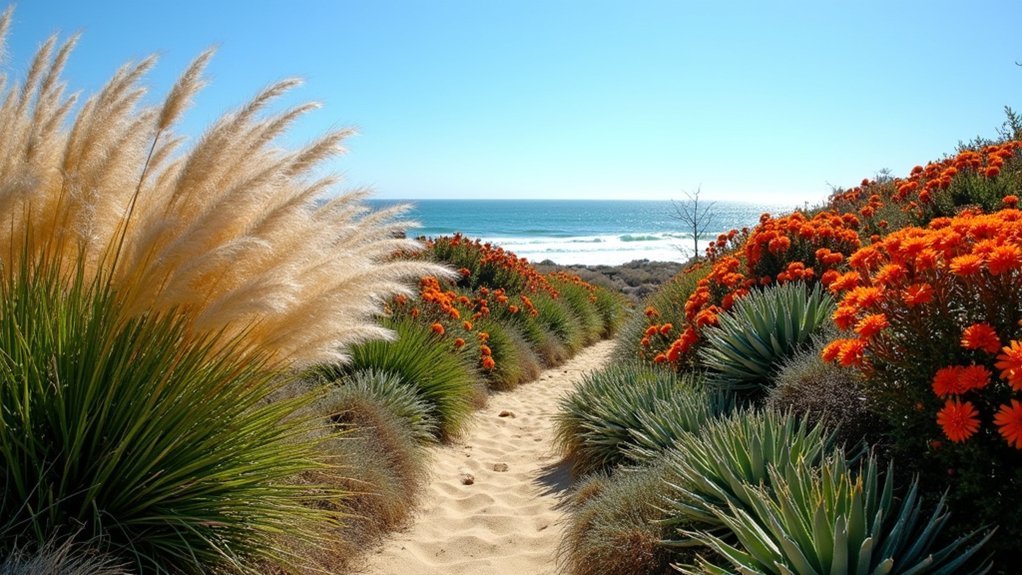
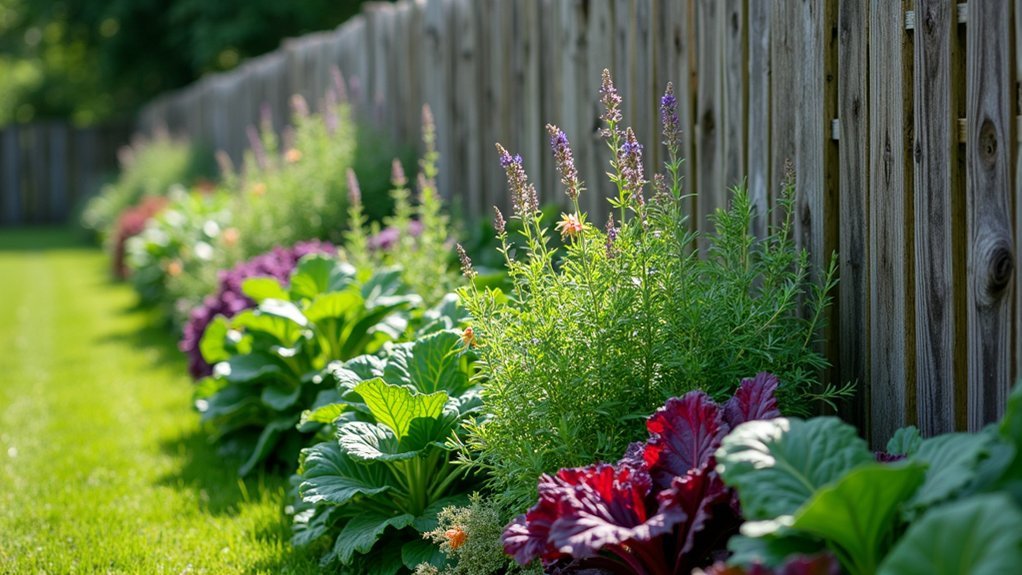
Leave a Reply